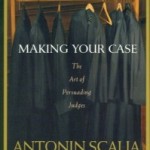
One of my favorite books offering advice on lawyering is Making Your Case: The Art of Persuading Judges by Antonin Scalia and Bryan A. Garner. Here are a few of the more surprising and noteworthy nuggets:
On Legal Writing
Don’t ever begin with a statement of facts. State the issues first.
Never use underlining in briefs. And don’t use bold type except in headings (the authors call this “visually repulsive”).
String cites should never be used except for propositions of law novel to the court.
The reply brief should be a self-contained document. That is, it should be comprehensible to the reader without having to refer to any other brief, as many judges and law clerks read the Reply first.
To have any chance of obtaining discretionary review, you must show that the lower court’s error consisted in the adoption of an erroneous and important rule of law, not merely the erroneous application of a rule correctly expressed.
On Oral Argument
If you’re the first to argue, make your affirmative arguments and then refute in the middle of your argument, not at the beginning or end.
Where the authors disagree the most: Mr. Garner is a well known advocate of placing citations in footnotes, while Justice Scalia disapproves of this practice. Although I do not place citations in footnotes, I have read briefs that do so, and the text does look “cleaner”. The reading also tends to flow more smoothly. Lengthy parallel citations and string cites can be awkward and distracting. This emerging “footnote” practice is in keeping with the general trend in the legal profession to make briefs as accessible and clear as possible. On the other hand, as Justice Scalia points out, laymen don’t read amicus briefs (nor do Judges), and lawyers have grown accustomed to skipping over citations to read the next substantive sentence.






